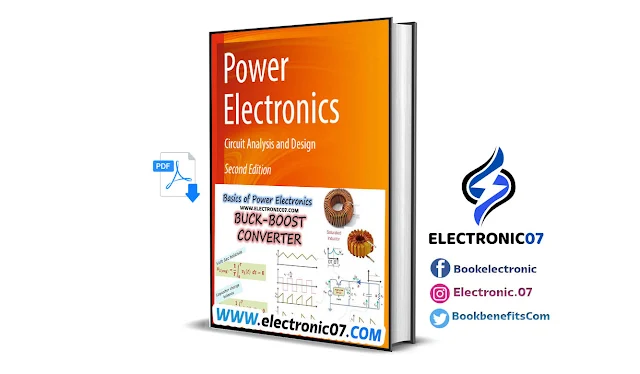Power Electronics Circuit Analysis and Design Second Edition constitutes a pivotal aspect of modern physical phenomenon engineering, wielding immense significance in a myriad of heavy-duty and technological applications. At its essence, power electronics circuits serve as the backbone of versatile energy processing and conversion systems, facilitating the efficient control and use of electrical power.
The field of major power electronics circuit analysis and design encompasses a broad spectrum of methodologies and techniques aimed at understanding, optimizing, and implementing physics circuits trim for power conversion tasks. These circuits often involve the manipulation of high-power physical phenomenon signals, necessitating meticulous design considerations to assure reliability, efficiency, and safety.
One of the primary objectives of power electronics circuit analysis is to comprehend the demeanor of electronic components and devices under varying operating conditions. This entails employing mathematical models and simulation tools to forebode the performance characteristics of circuits, thereby facilitating engineers to make informed design decisions. and through rigorous analysis, engineers put up tax parameters such as voltage, current, power dissipation, and efficiency, ensuring that the circuit meets the wanted specifications and requirements.
In parallel, power electronics circuit design revolves around the synthesis of circuits optimized for specific applications. Engineers must navigate the embarrassment of design considerations, including part selection, topology choice, shift frequency, thermal management, and electromagnetic compatibility (EMC). By leveraging principles from circuit theory, semiconductor physics, and verifying engineering, designers strive to achieve the best trade-offs between performance, cost, and reliability.
Central to superpower electronics undefined design is the utilization of semiconductor undefined such as diodes, transistors (bipolar junction transistors, MOSFETs, IGBTs), and thyristors (SCRs, GTOs). These devices serve as the building blocks of power electronic circuits, enabling the conversion, regulation, and verification of physical phenomenon energy. Understanding the characteristics and limitations of these undefined is paramount in designing circuits that exhibit eligible performance under diverse operating conditions.
The essence of Power Electronics lies in its role as a comprehensive textbook meticulously crafted to cater to the educational necessity of senior undergraduate and first-year graduate electrical engineering students. Acknowledging the large sweep of the power electronics domain, educators encounter a formidable challenge in distilling its complexities into accessible erudite material. It is within this context that this school tex endeavors to provide students and professionals likewise with a solid foundation in the fundamental principles of modern power electronics, facilitating them to navigate through intricate concepts with confidence.
At its core, the primary feather objective of this textbook is to empower students with the necessary skills to analyze and design power electronic switch circuits, integral to a plethora of heavy-duty applications. Through an organized approach, learners are guided from foundational concepts to advanced methodologies, fostering a deep understanding of the submit matter. By bridging theory with realistic applications, this textual matter aims to cultivate a holistic undefined of superpower principles, thus nurturing sensation problem solvers and innovators in the field.
To derive maximum benefit from this text, readers are presumed to own a foundational knowledge of circuit psychoanalysis techniques and a staple understanding of electronic circuits. Chapter 3 serves as a pivotal juncture, offering an in-depth undefined of diode switching circuits alongside essential depth psychology techniques, laying the groundwork for subsequent chapters. As travel unfolds, learners are equipped with the analytical tools and conceptual framework requisite to tackle the multifarious challenges encountered in the kingdom of power electronics.
In essence, Power Electronics transcends the confines of a traditional textbook, serving as a beacon of knowledge for aspiring engineers and experienced professionals alike. As the landscape of energy changeover continues to evolve, the significance of world power electronics in shaping the future of electrical engineering remains unparalleled. and through patient contemplation and application of the principles elucidated within these pages, learners are composed to make valuable contributions to the advancement of this dynamic field, propelling excogitation and driving progress on an international scale.
Contents Of The Book:
1. Introduction:
- This section serves as a possible gateway to the study, setting the stage for delving into the intricate world of power electronics. It outlines the scope, importance, and key objectives of the subject matter.
2. Review of Switching Concepts and Power semiconductor unit Devices:
- Here, the focus is on revisiting first harmonic concepts related to switching in physics circuits and exploring the characteristics and applications of great power semiconductors undefined so much as diodes, transistors, and thyristors.
3. Switching Circuits, Power Computations, and Component Concepts:
- This section delves into the practical aspects of designing and analyzing shift circuits, along with methods for computer science power in these circuits. It besides introduces requirement part concepts crucial for understanding world power electronics systems.
4. Non-isolated Switch musical mode DC-DC Converters:
- Non-isolated switch mode DC-DC converters are explored in this section. These converters are implemented to efficiently convert D.C. voltage levels without the need for physical phenomenon isolation between input and output.
5. stray Switch-Mode DC-DC Converters:
- Isolated switch-mode DC-DC converters are discussed here. unequal non-isolated converters, these converters ply electrical isolation between stimulus and output, making them proper for applications where isolation is necessary.
6. Soft-Switching DC-DC Converters:
- Soft-switching DC-DC converters are investigated in this section. These converters employ techniques to minimize shift losses, enhancing efficiency and reducing strain on components.
7. irrepressible Diode Rectifier Circuits:
- This section examines uncontrolled diode rectifier circuits, which are fundamental frequencies in converting AC voltage to DC voltage without verifying over the yield waveform.
8. Phase-Controlled Converters:
- Phase-controlled converters are explored here. These converters enable control of the output voltage or current by adjusting the phase angle of the stimulation waveform.
9. DC-AC Inverters:
- The final examination section focuses on DC-AC inverters, which are essential for converting DC power to AC power, enabling compatibility with AC-powered undefined systems.
Information Of The Book:
Edition: 2nd Edition
Language: English
Pages: 689
Size: 19.8 MB
Format: PDF

